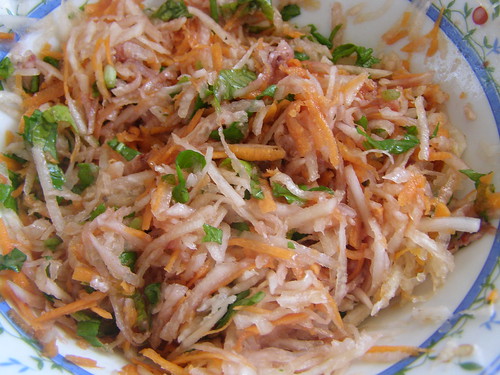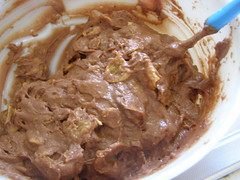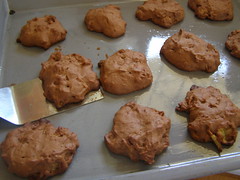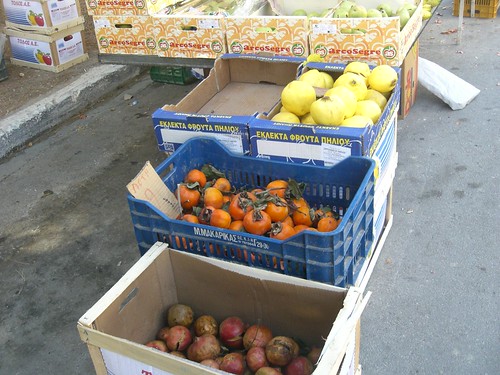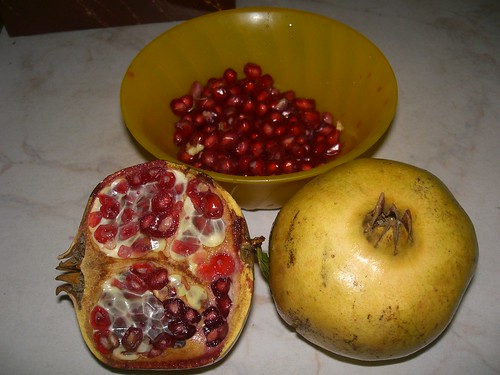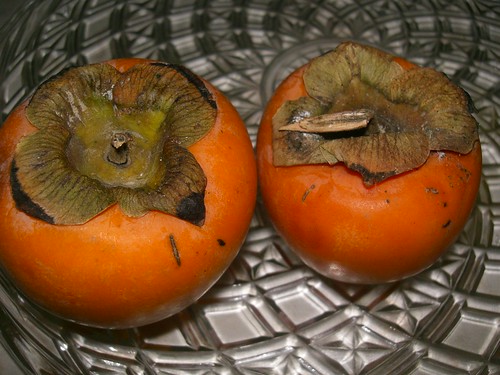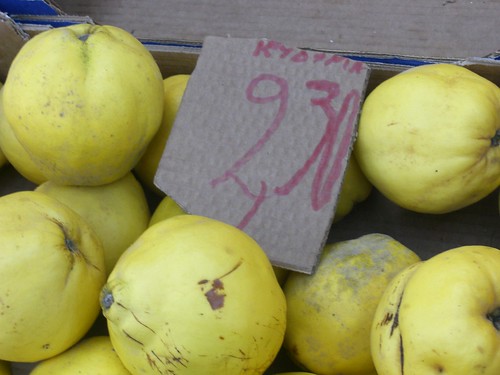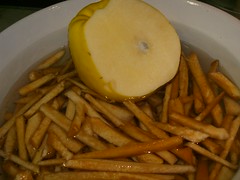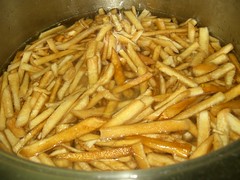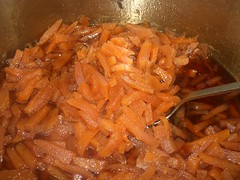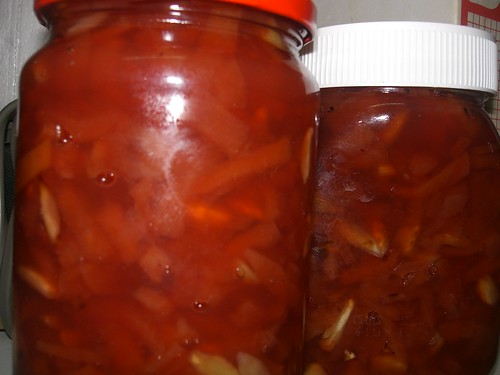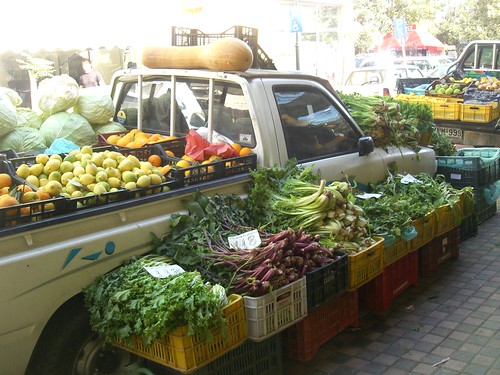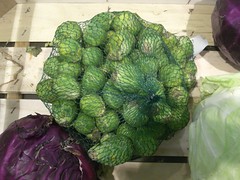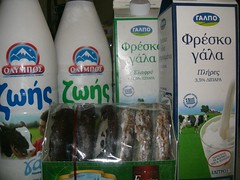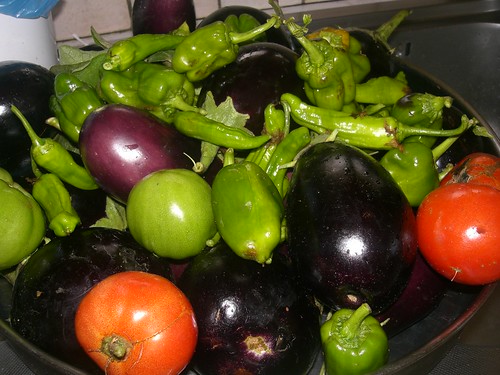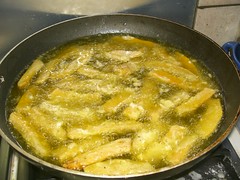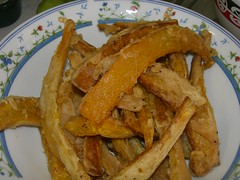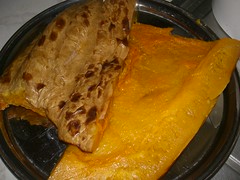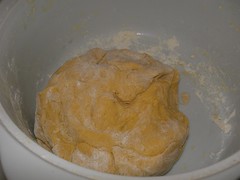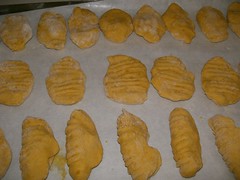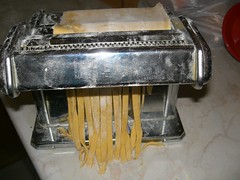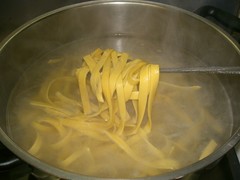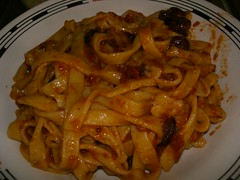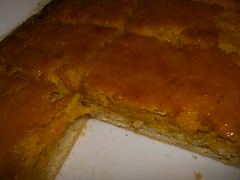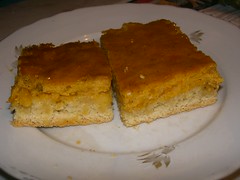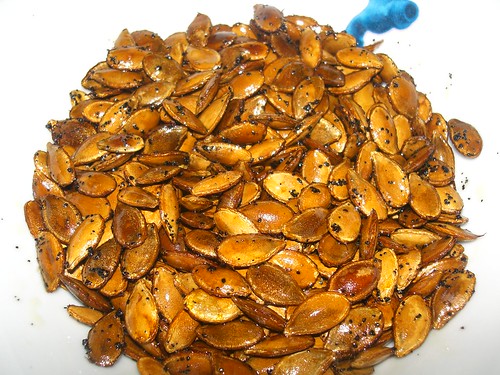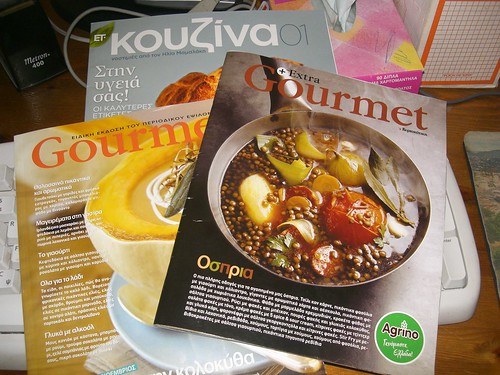
(Eleftheros Tipos offered a supplement with Mamalakis' recipes, while Kiriakatiki contained two supplements: one about beans and another about pumpkin)
A few weeks ago, there was a special Greek Gourmet magazine supplement in the Kiriakatiki Eleftherotipia, entitled Όσπρια' (Pulses - Beans). When he saw the advertisement on TV, hubby expressed great interest in procuring that particular newspaper, which we wouldn't have bought, had it not been for the supplement. My husband loves beans. He could eat fasolada every day, just like the Italians eat pasta as part of most main meals. He attributes his fanatical nature towards the humble bean to an unfortunate incident in his childhood, when he suffered from some peptic disorder. His mother took him to the doctor, who explicitly instructed her that her son should avoid all forms of gas-inducing food, which of course meant all kinds of beans. Much to his dismay, his mother would make fasolada for his father, another bean fanatic (the trait must be genetic - even one of the grandchildren seems to carry it), and cook a separate bland meal of boiled chicken and plain boiled rice for her son (which explains his present revulsion for chicken).
When the peptic disorder disappeared, and he no longer exhibited any symptoms of illness, he demanded a bowl of his mother's aromatic fasolada, but to no avail; his mother wanted to ensure that her son would never again suffer from any kind of peptic disorder, so she never let him eat any fasolada - for the next six years. One day, just before he became a teenager, my husband found a pot of fasolada simmering away unattended. He took the wooden spoon his mother used to stir the soup and ate a scoop of fasolada, just as it was, boiling hot. Then he ate another, and another, and another, until his mother came into the kitchen and caught him in the act.
"Get away from that pot!" she screamed, ranting lunatically out of fear for the worst, at the same time trying to expunge the spoon out of her son's hands. "The fasolada's gonna make your stomach explode!"
Her son made a run for it - but not before he took the pot with him. He ran a few hundred yards down the road, and hid in a nearby swamp (the present Gogoni Street in Hania), returning in the evening with the pot, completely empty of its contents. Since that day, nobody ever again attempted to stop him from eating fasolada, fava, lentil soup, black-eyed beans, chickpeas and yigantes, which pretty much covers the range of bean dishes his mother cooked in her kitchen.
So when he saw the advertisement for a 'free' magazine devoted wholly to bean recipes, he just had to have it.
"Don't bother," was my immediate reaction. "You won't want boiled lentils in your salad, mashed vegetables in your fava, kidney beans with bulgur wheat, grated carrot in lentil soup and yigantes with horta." He was astounded to hear these combinations being named by his wife, as I had never cooked them in our own home, nor had he heard of them being cooked in other homes. I explained to him the trend in Greek cuisine to 'update' an old favorite, use traditional ingredients in a novel way, basically, to cook in a more globalised fashion while still maintaining a Greek-Mediterranean element in the food. These new ideas were implemented by creative Athenian cooks, and are now permeating into Athenian restaurants, Greek food websites and younger people's cooking), but whose effects have not yet made an impact in the everyday Crete we live.
Not, of course, that there is anything wrong with inventing new recipes, revamping old ones, or giving a new look to age-old recipes. It just doesn't work in this environment, where people have been brought up on a traditional cuisine that hasn't changed much since the period of the Turkish occupation of the island. I don't need to tell you what might happen if I tweaked the basic recipes I use for my rotational weekly cuisine according to the season: the Third World War will break out from my kitchen.
I showed my hunter-hubby one of the recipes in one of the supplements: quails in a mustard and sage or tarragon) sauce, served with baked honey-glazed quince: 'Παπάρια' (paparia; 'balls'), leaving me simply to savour the photographs in the magazine for the time being. My reasons for rejecting someone else's recipe is based on other factors:
- Recipes (no matter how attractive they look) which use hard-to-source (therefore not local or well-known) ingredients are definitely not for my kitchen. It's great to try out new products, but do it on your own, unless you are sure that your family is more welcoming of new tastes, exotic aromas and quirky looking edibles.
- I sympathise with some people's abhorrence at mixing sweet or fruit ingredients into a savoury dish, although this is more a matter of how one has become conditioned to view food rather than a genuine dislike of the combination of sweet and savoury; these kinds of meals were probably never cooked in their home in the first place.
- When recipes call for the use of processed ingredients like ketchup, mayonnaise, baking mixes, and other unnatural or processed foods as their main ingredients, I feel they are simply trying to sell a product line, not trying to create a wholesome meal.
In Hania, people are stuck on old food favorites. The previous generation of cooks will pass on recipes to the next generation. What is served at home is also served in tavernas. Our tourists are used to this; they say it helps them to recognise what they're eating:
"Stifado? Oh, we had that in XYZ taverna."
"Biftekia? Oh, that's what we tried in ABC taverena."
"Yemista? Oh, my favorite recipe website featured those once on a Greek food special."
They won't forget those words or those tastes easily; they appear in all the menus of all the tavernas in the region. The Cretan mayeirio delivery menu (aimed mainly for busy working people) doesn't differ vastly from such tourist menus; almost everything that appears in my recipe index is listed in a typical mayeirio menu card, arranged in the typical way a Cretan mayeirio displays its wares. The menu is in Greek; an English translation is provided with links to my own site recipes:
'Nouveau cuisine' in Hania still has a long way to go. When I showed my husband a menu card from an Athenian mayeirio, he asked me who eats such food. Probably all sorts of people, mostly young people, progressive people, people tired of eating the same kind of food their mother makes at home, people game to try a new taste, people keen to avoid fatty meals with an excess of olive oil, people interested in new tastes, people on the road, people busy at work, hungry people who do not have the luxury of using fresh garden produce, the space to cook an elaborate meal or the time to do it. The menu card from this Athenian mayeirio reads very differently; there is not even any menu arrangement:
(The meals become progressively more expensive as you read the list...)
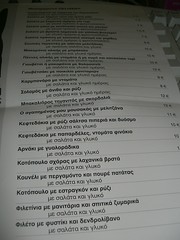
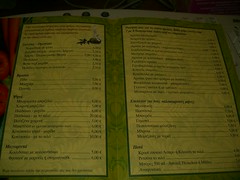
The meals mentioned in the Athenian mayeirio sounds nutritious and tasty. But they aren't cooked in the traditional Cretan kitchen. Wheat may be added to a meat soup, but pineapple and mango would never feature in a savoury dish, even if both are readily available fresh (they simply decorate the supermarket fresh produce counter, or are bought by foreigners, from what I know), cuttlefish and eggplant sauce wouldn't be served together, neither would meatballs and fennel... and so on.
There are many many times when I wish for something different, even if it means I have to cook it just for myself; if it doesn't look familiar, my family generally doesn't want it. That being said, at least they know what they want; some people are still searching.
I was recently inundated with weird and wonderful vegetables, which I had to use up somehow, even though I had never before used them in my cooking.

(Until my uncles started growing it this year - just for fun - I had never even seen kohlrabi before in my life; purple on the outside, white on the inside, it smells and tastes of cabbage.)
I actually invented a recipe for a salad. Although recipe creation is not my forte, I think I pulled it off quite nicely. I thought it would look great in one of those cuisine magazine supplements. Now all I need is to figure out a name for it...
You need:
1 small Daikon radish
1 kohlrabi
1 carrot
1 spring onion
a few sprigs of parsley OR rocket leaves
salt
olive oil
balsamic vinegar (optional)
Grate the radish, carrot and kohlrabi into a bowl. Chop the spring onion and parsley or rocket finely, and add to the other vegetables. Dress the salad with salt and olive oil. A sprinkle of balsamic vinegar woudn't go amiss, either.
Enjoy as a side dish with a main course, or as a main dish with some good cheese (and red wine).
